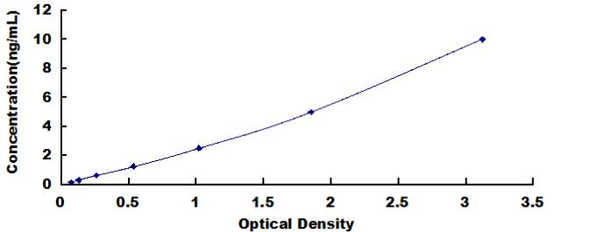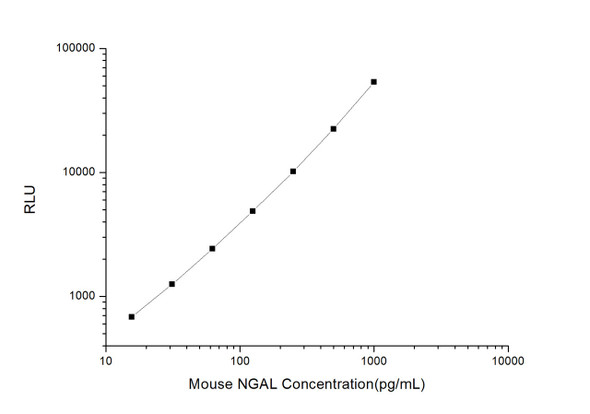Human Cell Death ELISA Kits
Human NGAL (Neutrophil Gelatinase Associated Lipocalin) CLIA Kit (HUES00092)
- SKU:
- HUES00092
- Product Type:
- ELISA Kit
- ELISA Type:
- CLIA Kit
- Size:
- 96 Assays
- Sensitivity:
- 18.75pg/mL
- Range:
- 31.25-2000pg/mL
- ELISA Type:
- Sandwich
- Synonyms:
- LCN2, Lipocalin 2, Oncogene 24p3, MSFI
- Reactivity:
- Human
- Sample Type:
- Serum, plasma and other biological fluids
- Research Area:
- Cell Death
Description
| Assay type: | Sandwich |
| Format: | 96T |
| Assay time: | 4.5h |
| Reactivity: | Human |
| Detection method: | Chemiluminescence |
| Detection range: | 31.25-2000 pg/mL |
| Sensitivity: | 18.75 pg/mL |
| Sample volume: | 100µL |
| Sample type: | Serum, plasma and other biological fluids |
| Repeatability: | CV < 15% |
| Specificity: | This kit recognizes Human NGAL in samples. No significant cross-reactivity or interference between Human NGAL and analogues was observed. |
This kit uses Sandwich-CLIA as the method. The micro CLIA plate provided in this kit has been pre-coated with an antibody specific to Human NGAL. Standards or samples are added to the appropriate micro CLIA plate wells and combined with the specific antibody. Then a biotinylated detection antibody specific for Human NGAL and Avidin-Horseradish Peroxidase (HRP) conjugate are added to each micro plate well successively and incubated. Free components are washed away. The substrate solution is added to each well. Only those wells that contain Human NGAL, biotinylated detection antibody and Avidin-HRP conjugate will appear fluorescence. The Relative light unit (RLU) value is measured spectrophotometrically by the Chemiluminescence immunoassay analyzer. The RLU value is positively associated with the concentration of Human NGAL. The concentration of Human NGAL in the samples can be calculated by comparing the RLU of the samples to the standard curve.
| UniProt Protein Function: | LCN2: Iron-trafficking protein involved in multiple processes such as apoptosis, innate immunity and renal development. Binds iron through association with 2,5-dihydroxybenzoic acid (2,5- DHBA), a siderophore that shares structural similarities with bacterial enterobactin, and delivers or removes iron from the cell, depending on the context. Iron-bound form (holo-24p3) is internalized following binding to the SLC22A17 (24p3R) receptor, leading to release of iron and subsequent increase of intracellular iron concentration. In contrast, association of the iron-free form (apo-24p3) with the SLC22A17 (24p3R) receptor is followed by association with an intracellular siderophore, iron chelation and iron transfer to the extracellular medium, thereby reducing intracellular iron concentration. Involved in apoptosis due to interleukin-3 (IL3) deprivation: iron-loaded form increases intracellular iron concentration without promoting apoptosis, while iron-free form decreases intracellular iron levels, inducing expression of the proapoptotic protein BCL2L11/BIM, resulting in apoptosis. Involved in innate immunity, possibly by sequestrating iron, leading to limit bacterial growth. Belongs to the calycin superfamily. Lipocalin family. 2 isoforms of the human protein are produced by alternative splicing. |
| UniProt Protein Details: | Protein type:Secreted; Secreted, signal peptide Chromosomal Location of Human Ortholog: 9q34 Cellular Component: extracellular space; extracellular region; cytosol Molecular Function:protein homodimerization activity; protease binding; transporter activity; iron ion binding Biological Process: response to drug; cellular response to nutrient levels; cellular iron ion homeostasis; response to virus; siderophore transport; positive regulation of cell projection organization and biogenesis; innate immune response; ion transport; response to herbicide; transmembrane transport |
| UniProt Code: | P80188 |
| NCBI GenInfo Identifier: | 1171700 |
| NCBI Gene ID: | 3934 |
| NCBI Accession: | P80188. 2 |
| UniProt Secondary Accession: | P80188,P30150, Q5SYV9, Q5SYW0, Q6FGL5, Q92683, A6NII8 B4DWV4, B7ZAA2, |
| UniProt Related Accession: | P80188 |
| Molecular Weight: | |
| NCBI Full Name: | Neutrophil gelatinase-associated lipocalin |
| NCBI Synonym Full Names: | lipocalin 2 |
| NCBI Official Symbol: | LCN2 |
| NCBI Official Synonym Symbols: | 24p3; MSFI; NGAL |
| NCBI Protein Information: | neutrophil gelatinase-associated lipocalin; p25; lipocalin-2; oncogene 24p3; siderocalin LCN2; migration-stimulating factor inhibitor; 25 kDa alpha-2-microglobulin-related subunit of MMP-9 |
| UniProt Protein Name: | Neutrophil gelatinase-associated lipocalin |
| UniProt Synonym Protein Names: | 25 kDa alpha-2-microglobulin-related subunit of MMP-9; Lipocalin-2; Oncogene 24p3; Siderocalin LCN2; p25 |
| Protein Family: | Neutrophil gelatinase-associated lipocalin |
| UniProt Gene Name: | LCN2 |
| UniProt Entry Name: | NGAL_HUMAN |
As the RLU values of the standard curve may vary according to the conditions of the actual assay performance (e. g. operator, pipetting technique, washing technique or temperature effects), the operator should establish a standard curve for each test. Typical standard curve and data is provided below for reference only.
| Concentration (pg/mL) | RLU | Average | Corrected |
| 2000 | 50976 60466 | 55721 | 55693 |
| 1000 | 22505 25443 | 23974 | 23946 |
| 500 | 11699 10365 | 11032 | 11004 |
| 250 | 4888 5700 | 5294 | 5266 |
| 125 | 2764 2452 | 2608 | 2580 |
| 62.5 | 1374 1248 | 1311 | 1283 |
| 31.25 | 629 719 | 674 | 646 |
| 0 | 28 28 | 28 | -- |
Precision
Intra-assay Precision (Precision within an assay): 3 samples with low, mid range and high level Human NGAL were tested 20 times on one plate, respectively.
Inter-assay Precision (Precision between assays): 3 samples with low, mid range and high level Human NGAL were tested on 3 different plates, 20 replicates in each plate.
| Intra-assay Precision | Inter-assay Precision | |||||
| Sample | 1 | 2 | 3 | 1 | 2 | 3 |
| n | 20 | 20 | 20 | 20 | 20 | 20 |
| Mean (pg/mL) | 100.80 | 190.47 | 894.54 | 92.78 | 207.90 | 905.47 |
| Standard deviation | 10.15 | 19.12 | 67.63 | 11.66 | 18.86 | 81.22 |
| C V (%) | 10.07 | 10.04 | 7.56 | 12.57 | 9.07 | 8.97 |
Recovery
The recovery of Human NGAL spiked at three different levels in samples throughout the range of the assay was evaluated in various matrices.
| Sample Type | Range (%) | Average Recovery (%) |
| Serum (n=5) | 98-109 | 104 |
| EDTA plasma (n=5) | 97-111 | 103 |
| Cell culture media (n=5) | 93-103 | 98 |
Linearity
Samples were spiked with high concentrations of Human NGAL and diluted with Reference Standard & Sample Diluent to produce samples with values within the range of the assay.
| Serum (n=5) | EDTA plasma (n=5) | Cell culture media (n=5) | ||
| 1:2 | Range (%) | 91-105 | 99-113 | 96-113 |
| Average (%) | 97 | 107 | 103 | |
| 1:4 | Range (%) | 102-115 | 93-106 | 86-100 |
| Average (%) | 109 | 100 | 93 | |
| 1:8 | Range (%) | 95-111 | 87-103 | 99-114 |
| Average (%) | 102 | 94 | 105 | |
| 1:16 | Range (%) | 87-98 | 92-104 | 86-98 |
| Average (%) | 92 | 97 | 93 |
An unopened kit can be stored at 4°C for 1 month. If the kit is not used within 1 month, store the items separately according to the following conditions once the kit is received.
| Item | Specifications | Storage |
| Micro CLIA Plate(Dismountable) | 8 wells ×12 strips | -20°C, 6 months |
| Reference Standard | 2 vials | |
| Concentrated Biotinylated Detection Ab (100×) | 1 vial, 120 µL | |
| Concentrated HRP Conjugate (100×) | 1 vial, 120 µL | -20°C(shading light), 6 months |
| Reference Standard & Sample Diluent | 1 vial, 20 mL | 4°C, 6 months |
| Biotinylated Detection Ab Diluent | 1 vial, 14 mL | |
| HRP Conjugate Diluent | 1 vial, 14 mL | |
| Concentrated Wash Buffer (25×) | 1 vial, 30 mL | |
| Substrate Reagent A | 1 vial, 5 mL | 4°C (shading light) |
| Substrate Reagent B | 1 vial, 5 mL | 4°C (shading light) |
| Plate Sealer | 5 pieces | |
| Product Description | 1 copy | |
| Certificate of Analysis | 1 copy |
- Set standard, test sample and control (zero) wells on the pre-coated plate and record theirpositions. It is recommended to measure each standard and sample in duplicate. Note: addall solutions to the bottom of the plate wells while avoiding contact with the well walls. Ensuresolutions do not foam when adding to the wells.
- Aliquot 100µl of standard solutions into the standard wells.
- Add 100µl of Sample / Standard dilution buffer into the control (zero) well.
- Add 100µl of properly diluted sample (serum, plasma, tissue homogenates and otherbiological fluids. ) into test sample wells.
- Cover the plate with the sealer provided in the kit and incubate for 90 min at 37°C.
- Aspirate the liquid from each well, do not wash. Immediately add 100µL of BiotinylatedDetection Ab working solution to each well. Cover the plate with a plate seal and gently mix. Incubate for 1 hour at 37°C.
- Aspirate or decant the solution from the plate and add 350µL of wash buffer to each welland incubate for 1-2 minutes at room temperature. Aspirate the solution from each well andclap the plate on absorbent filter paper to dry. Repeat this process 3 times. Note: a microplatewasher can be used in this step and other wash steps.
- Add 100µL of HRP Conjugate working solution to each well. Cover with a plate seal andincubate for 30 min at 37°C.
- Aspirate or decant the solution from each well. Repeat the wash process for five times asconducted in step 7.
- Add 100µL of Substrate mixture solution to each well. Cover with a new plate seal andincubate for no more than 5 min at 37°C. Protect the plate from light.
- Determine the RLU value of each well immediately.






